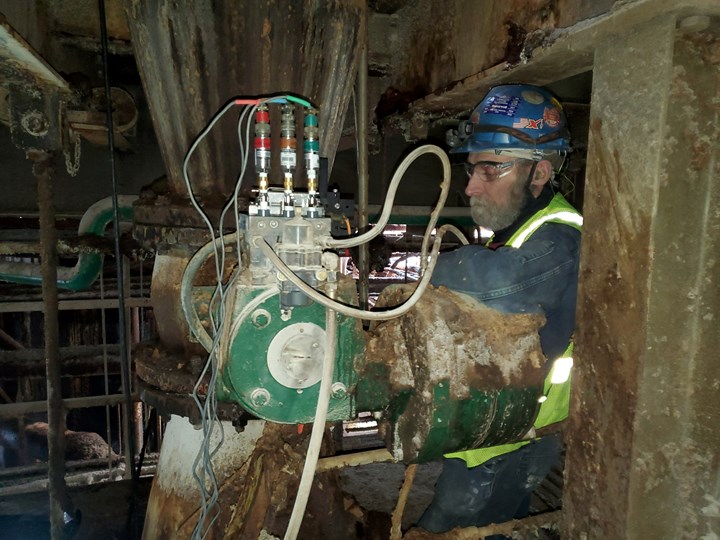Inspection and Maintenance Can Alleviate Supply Chain Woes
As industrial companies confront the challenges posed by global supply chain constraints, extra attention should be paid to maintenance as a strategy for minimizing the need for new equipment and components.
#pressure-relief #maintenance-repair
Some days it seems as if modern industrial plants have adopted the tech industry’s motto: Move fast and break things. Having become accustomed to a smoothly operating global supply chain and reasonable costs for replacement parts, many plant owners and managers figured it was easier and cheaper to run components to failure rather than invest in inspection and maintenance to extend the life of non-consumables. The recent global supply chain constraints have changed that calculus.
An employee of SVI Industrial performs a diagnostic test on a control valve. Photo credit: Courtesy of SVI Industrial
In many cases, supply is just part of the problem. Escalating costs and questionable quality of equipment and parts from manufacturers that can meet demand compounds the difficulty of ensuring uptime. There’s a better alternative to betting on unvetted suppliers: enhanced inspection and maintenance services provided by trusted, certified partners who are familiar with all laws, regulations and codes.
ENHANCED MAINTENANCE IS PART OF THE NEW NORMAL
As frustrating as the current supply chain challenges are, they may remind plant owners why many codes and jurisdictions call for regular inspection and maintenance of specific equipment and systems. Inspection and analysis of critical plant systems can uncover hidden or silent degradation before it becomes a problem that affects plant productivity or creates a safety hazard. Inspections that identify early-stage problems in tubing, piping, valves and other components can buy operators the time needed to place orders for long lead-time components.
In the meantime, early awareness of developing material wear or unexpected leaks gives plant operators a chance to extend component life with professional maintenance, repair and on-site services.
REQUIRED AND PREVENTIVE MAINTENANCE
In addition to engaging appropriate professional trades to conduct all inspections and maintenance activities required by law and applicable codes, today’s circumstances call for more proactive preventive maintenance schedules.
Advances in digitally connected plants and data analytics have allowed many industries to run their complex machinery nearly to the point of failure before predictive maintenance is scheduled. However, when the availability of replacement parts is uncertain, that approach can be costly. The information provided by sensors and automated programs remains essential, but savvy operators will be adjusting the parameters of their systems to ensure that they aren’t operating as close to the edge as was feasible pre-pandemic.
REPAIR RATHER THAN REPLACE TO SAVE TIME AND MONEY
In the past, it may have been faster to replace rather than repair some valves, especially smaller-diameter ones. However, in today’s environment, instead of a possible two- to three-day lead time for delivery, many valves and other parts aren’t in stock, so we are seeing much longer lead times. With greater supply chain uncertainty, maintenance can be a time saver even for parts you might have replaced previously.
For bigger valves on larger-diameter pipes, anywhere from 2-20 in. and up, it is typically less expensive to repair than to replace—unless, of course, you’re looking at a catastrophic failure caused by a steam erosion or by severe corrosion.
Another way repairs can save you time and money is when a valve is welded in line. Instead of cutting out the old valve and welding the new one in line, a qualified repair service can manage the in-line repair much quicker and less expensively.
MAINTAIN VALVES TO MAINTAIN SAFETY, RELIABILITY AND ECONOMIC VIABILITY
Though industry veterans and executives usually understand the implications of ignoring valve performance, newer employees or those shifting to new roles may not. One way to communicate the importance of proper valve inspection and maintenance—and the importance of alerting managers if staff see any valves that aren’t operating as expected—is to train everyone on the physical dangers posed by improperly operating valves. For example, a leaking valve that blows steam or hot liquid can cause burns and other injuries to individuals who need to work around that valve.
Other problems caused by failing valves often result in decreased plant reliability, lost productivity, and economic penalties. If a pressure-control valve locks up because the diaphragm blows or buildup (caused by too-infrequent maintenance) causes it to stick, it will shut down the process that relies upon that valve. When an improperly maintained pressure-relief valve blows, it may not reseat and close properly when the pressure in the line goes back down. The result can be an entire system or plant shutdown, because you can’t have that valve blowing indefinitely.
Even if a valve doesn’t completely fail, a compromised one can cause a system to operate at less than full capacity. A leaking valve means your plant is losing energy or product, which means plant productivity and economics suffer.
AVOID COMPLACENCY
Small things can have oversized consequences. Valve failure can bring your entire plant down, so don’t accept the risks of skipping appropriate inspection and maintenance. Furthermore, there’s no clear sign that supply chain woes will end any time soon, so investments in more-frequent inspections and maintenance may deliver a larger return than plant operators are used to associating with maintenance costs.
About the Author
Ben Medlock is director of Valve and Machining Services at SVI Industrial.
RELATED CONTENT
-
Misconceptions Regarding Control and Isolation Valve Standards
All on/off isolation valve standards are not created equal and cannot be applied unilaterally to all valves.
-
Creating a Standard for Severe Service Valves
Severe service valves are offered in several standard designs, including non-return, isolation and control types.
-
An Overview of ASME B16.34-2017
The content of American Society of Mechanical Engineers (ASME) Standard B16.34 is essential to those who deal with flanged, threaded and welded-end valves.








 Unloading large gate valve.jpg;maxWidth=214)


